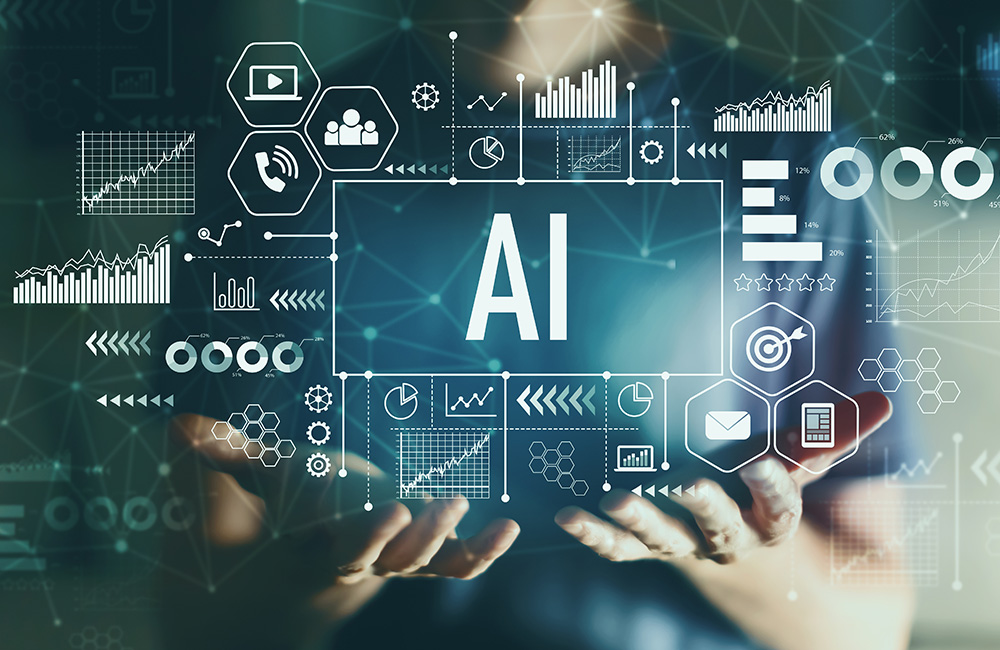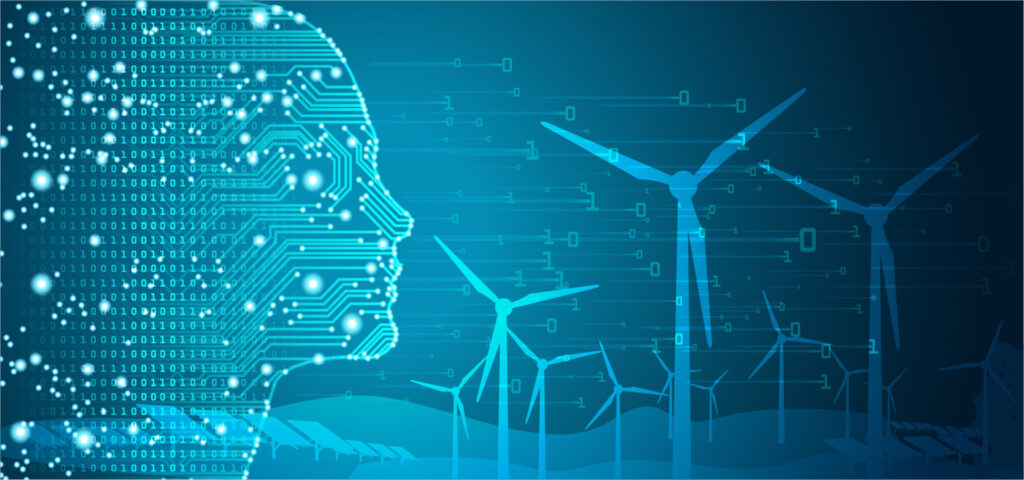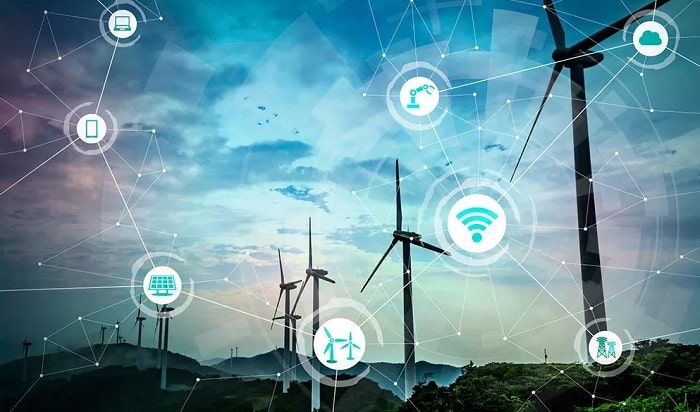Welcome to our Blog on the transformative power of artificial intelligence (AI) in the realm of
energy management. We are witnessing the transformative power of Artificial Intelligence (AI) across
various industries, and the energy sector is no exception. As the demand for sustainable and efficient energy solutions continues to rise, AI and robotics are playing a crucial role in optimizing energy management, improving grid operations, and enhancing decision-making processes.

Introduction
The energy sector holds immense importance in driving economic growth and ensuring societal well-being.
However, traditional energy systems face numerous challenges, including the need for increased efficiency,
grid stability, and the integration of renewable energy sources. AI presents promising solutions by enabling
advanced analytics, automation, and optimization techniques that effectively address these challenges.
What is AI?
Before we explore the applications of AI in the energy sector, let’s begin by briefly defining what AI entails.
AI refers to the development of computer systems capable of performing tasks that typically require human
intelligence. These systems leverage algorithms and machine learning techniques to analyze vast amounts of data, identify patterns, make predictions, and generate insights.

Application of AI in the Energy Sector
Energy Forecasting and Optimization
Accurate forecasting plays a crucial role in ensuring the stability of energy systems. AI algorithms,
powered by historical data and machine learning models, provide highly precise energy demand and supply forecasts. This information enables energy providers to optimize production schedules, balance load requirements, and allocate resources effectively. By minimizing energy wastage and maximizing the utilization of renewable energy, AI-driven optimization enhances overall system efficiency.
Predictive Maintenance
Predictive maintenance is another area where AI is making significant strides in the energy sector. By leveraging sensor data and machine learning algorithms, AI systems can detect anomalies, predict equipment failures, and proactively schedule maintenance activities. This approach helps reduce downtime, increase the lifespan of assets, and optimize maintenance costs.
Demand Response
AI-powered demand response systems are revolutionizing how we manage and balance electricity consumption. Through real-time monitoring and predictive analytics, these systems intelligently adjust energy demand based on supply, grid conditions, and pricing signals. By optimizing energy usage patterns, AI helps reduce peak loads, mitigate grid instability, and minimize operational costs for both consumers and energy providers.
Renewable Energy Integration
The integration of renewable energy sources into the grid poses unique challenges due to their intermittent
nature. AI technologies can help overcome these challenges by optimizing the deployment and operation of
renewable energy assets, predicting renewable energy generation, and efficiently managing energy storage systems.
Smart Grid Management
The integration of AI into smart grid infrastructure has unlocked unprecedented possibilities for energy
management. AI algorithms analyze vast amounts of data from sensors, meters, and other devices, enabling
real-time monitoring, fault detection, and predictive maintenance. It will make the grid more reliable and easy to use.
Energy Trading and Pricing
AI is revolutionizing energy trading and pricing by automating trading activities, predicting market trends,
and optimizing energy portfolios. AI systems can analyze large datasets, identify trading opportunities, and
execute trades at high speeds, leading to improved profitability and reduced market risks.
Benefits of AI in the Energy Sector
The adoption of AI in the energy sector brings several significant benefits:

Increased Efficiency and Cost Savings
By leveraging AI-powered analytics and optimization techniques, energy systems can operate more efficiently, resulting in reduced energy wastage, lower operational costs, and increased overall system efficiency.
Enhanced Reliability and Resilience
AI enables proactive fault detection and predictive maintenance, leading to increased reliability and
resilience of energy infrastructure. This reduces the likelihood of equipment failures, minimizes downtime,
and improves the overall quality of energy services.
Better Decision-Making
AI systems provide valuable insights by analyzing complex data and generating actionable recommendations.
This empowers decision-makers in the energy sector to make informed choices regarding resource allocation,
infrastructure planning, and policy formulation.
Environmental Sustainability
The integration of AI and renewable energy technologies promotes environmental sustainability by optimizing energy generation and consumption patterns. This helps reduce greenhouse gas pollution, fight climate change, and make the future of energy more sustainable.
Challenges and Limitations
While AI offers numerous benefits, its adoption in the energy sector also comes with challenges and
limitations that need to be addressed:
Data Availability and Quality
AI systems heavily rely on data to train and operate effectively. However, the energy sector faces challenges
in terms of data availability, interoperability, and quality. Ensuring access to high-quality data from various
sources is crucial for AI to deliver accurate and reliable results.
Privacy and Security Concerns
The increasing use of AI in energy systems raises concerns about privacy and data security. Protecting sensitive customer data and ensuring secure communication between devices and systems is essential to maintain trust and confidence in AI-enabled energy solutions.
Ethical Considerations
AI deployment in the energy sector raises ethical considerations related to fairness, transparency, and accountability. It is important to ensure that AI systems are unbiased, explainable, and adhere to ethical standards, avoiding discrimination and unintended negative consequences.
Case Studies: AI in the Energy Sector

Let’s delve into a few case studies that highlight the practical applications of AI in the energy sector:
Smart Grids and AI
AI plays a vital role in transforming traditional power grids into smart grids. Smart grids leverage AI algorithms to monitor and control energy flows, optimize distribution, and enable bidirectional
communication between utilities and consumers. This results in improved grid reliability, enhanced
energy efficiency, and better integration of distributed energy resources.
AI in Energy Trading
Energy trading involves complex market dynamics and real-time decision-making. AI-based trading
platforms leverage machine learning algorithms to analyze market data, identify trends, and execute trades.
These platforms enable faster decision-making, improved risk management, and enhanced profitability for energy traders.
AI-enabled Energy Analytics
AI-powered energy analytics platforms analyze massive volumes of data from sensors, weather forecasts,
and energy consumption patterns to provide valuable insights. These insights help utilities and consumers
optimize energy usage, identify energy-saving opportunities, and effectively plan for future energy needs.
Future Trends and Outlook
The future of AI in the energy sector looks promising. Some key trends to watch out for include:
- Continued advancements in machine learning algorithms enable more accurate predictions and better
decision-making capabilities. - Increased adoption of AI in distributed energy systems, enabling seamless integration of renewable
energy resources and microgrids. - AI-driven autonomous systems for energy management, optimizing energy consumption patterns and
grid operations without human intervention. - Enhanced cybersecurity measures to protect AI-enabled energy infrastructure from cyber threats.
- To support AI-driven energy management, consumers must be educated. Energy companies should inform customers about AI’s cost savings, environmental sustainability, and reliability. Also, friendly discussion and simple user interfaces build trust and participation.
- Policymakers must provide beneficial regulatory frameworks for energy sector AI integration. These frameworks should promote innovation, competition, data protection, security, and responsible artificial intelligence deployment.
Conclusion

AI in the energy sector is changing the energy business by making energy systems better and more efficient. By embracing this technological transformation and fostering collaboration, we can unlock the full benefits of AI and accelerate the transition towards a greener, more efficient energy landscape. From energy management and optimization to grid operations and renewable energy integration, AI can save money, make things more reliable, and keep going for a long time. However, challenges related to data quality, privacy, security, and ethics need to be addressed to unlock the full benefits of AI.
FAQs
What is the role of AI in the energy sector?
AI in the energy sector refers to the application of artificial intelligence techniques and technologies to improve energy management, optimize grid operations, and enhance decision-making processes.
How does AI benefit the energy sector?
AI brings benefits such as increased efficiency, enhanced reliability, better decision-making, and environmental sustainability to the energy sector.
What are the challenges of adopting AI in the energy sector?
Challenges include data availability and quality, privacy and security concerns, and ethical considerations regarding fairness and transparency.
Can AI help integrate renewable energy sources into the grid?
Yes, AI can optimize the deployment and operation of renewable energy assets, predict renewable energy generation, and efficiently manage energy storage systems, facilitating the integration of renewable energy into the grid.
What are the future trends of AI in the energy sector?
Future trends include advancements in machine learning algorithms, increased adoption of AI in distributed energy systems, autonomous energy management systems, and enhanced cybersecurity measures.
What does AI do in the power industry?
AI in energy helps with tracking power grids in real-time, making more accurate predictions of power fluctuations, and coming up with new ways to use geothermal energy sources.
What kinds of things could AI do in the future to help with the power grid?
AI can help reduce energy waste, lower costs, and speed up the use of clean, green energy sources in power lines around the world.
Can AI change the way the power system works?
Yes, with AI-driven automation, increased efficiency, and smarter decision-making.
How much electricity does AI use?
As per the data available, we can say that data centers need as much power as 50,000 houses. AI training takes more energy than regular computation. One model’s training uses more electricity than 100 US houses in a year.
How does AI improve how well energy is used?
AI controls how much energy is used and cuts it back during peak hours. It also finds problems and alerts people about them, and it finds machine failures before they happen.
What are some problems that come up when you use AI?
AI systems work by being taught with a set of data that is important to the problem they are trying to solve. There are some problems listed below
1. Outdated infrastructure
2. Lack of AI talent
3. Overestimating your AI system
4. Cost requirements
5. Integration with existing systems
How does AI change the way people will work in the future?
AI can automate many routine tasks and processes, which allows workers to focus on higher-level tasks and boosts efficiency. AI systems can handle a lot of data quickly and correctly, which reduces the chance of mistakes.
Can AI fix the problem with energy?
AI can also be used with smart grids and other energy systems to save energy and make them work better. AI algorithms can help predict how much energy will be needed and how much will be available, which can help change production and distribution.
How does artificial intelligence get most of its power?
AI is powered by a set of organized learning algorithms or code that looks at the data it is given. Open-source code programs like R and Python are often used to build the AI power that these programs model.
How does AI cut down on pollution?
AI can also help cut down on carbon pollution by making buildings use less energy that comes from fossil fuels.
